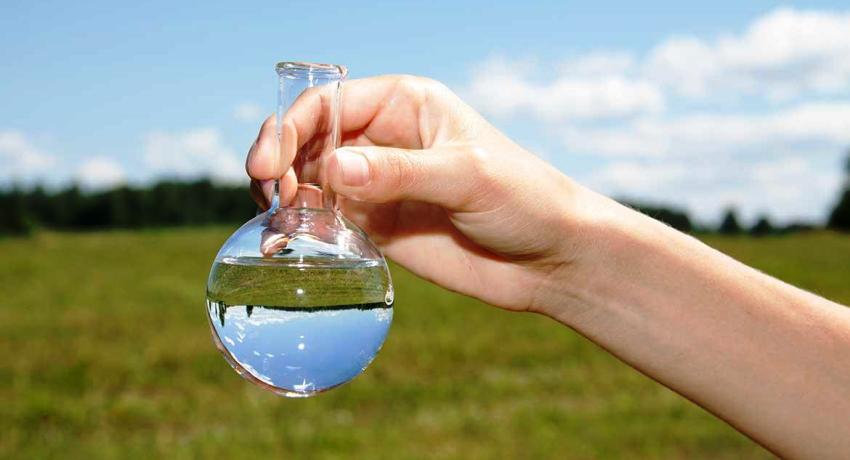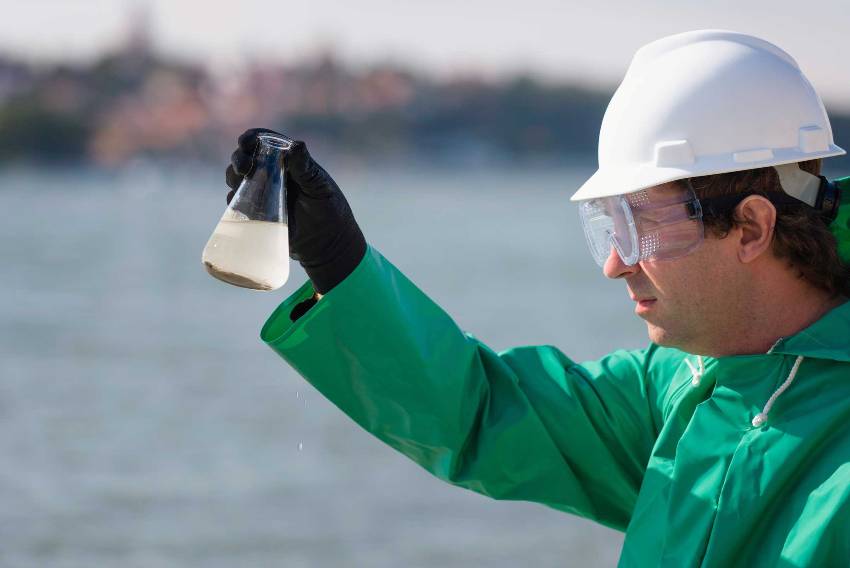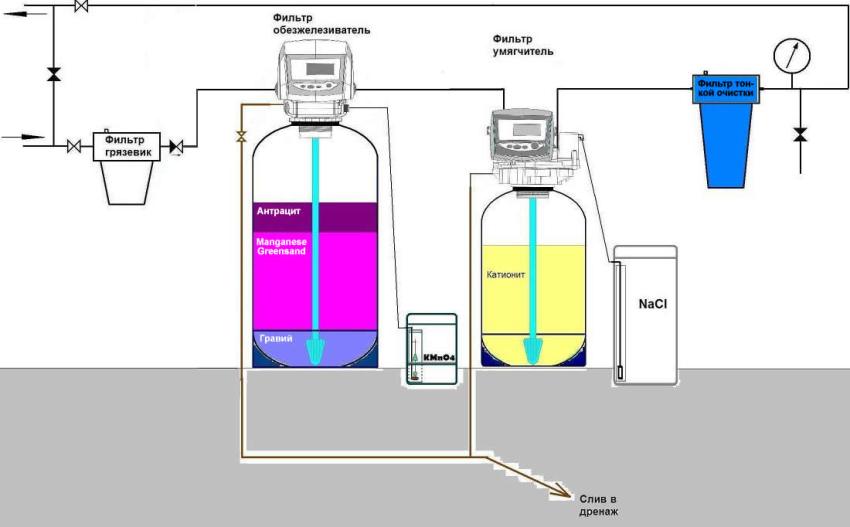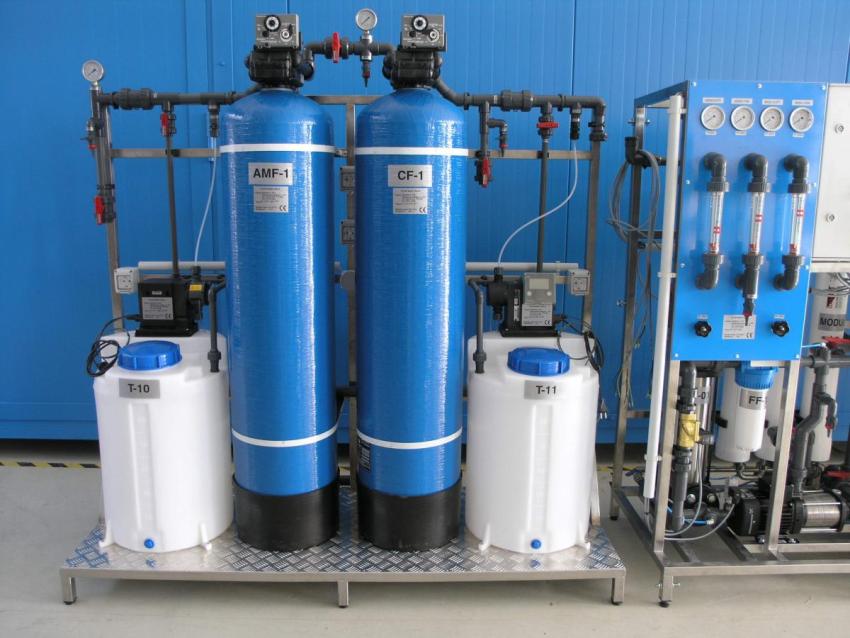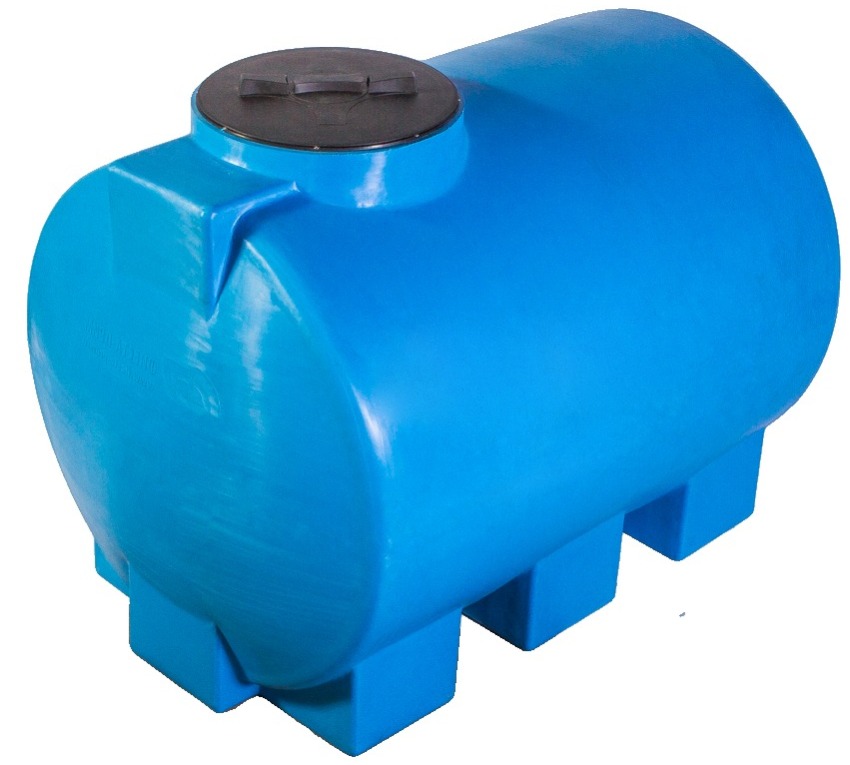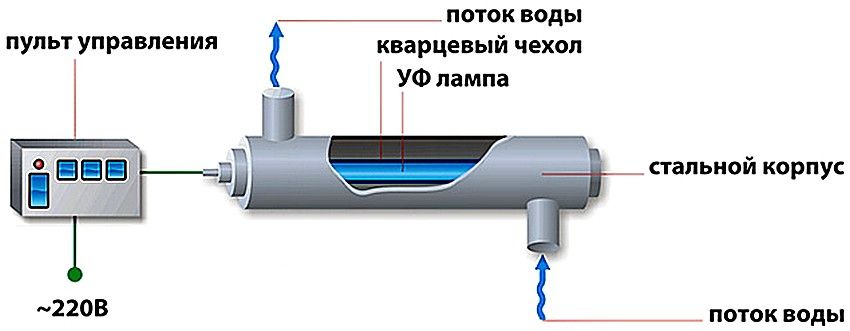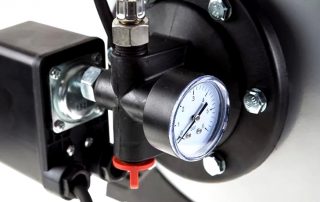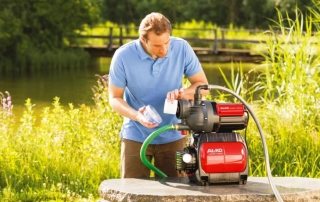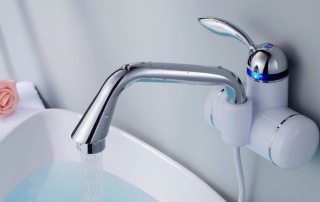Water is the basis of life. Its quality directly affects health, the physical condition of a person. Autonomous water supply is a good alternative to centralized water supply. Having organized an individual way of supplying water, you will have to take full responsibility for its quality. A common problem of suburban springs is an excess of iron in the water. Purification of water from iron from a well is becoming a top priority.
Content [Hide]
- 1 Iron content in drinking water
- 1.1 Well water analysis: sequence and prices
- 1.2 How to clean the well from harmful impurities?
- 1.3 Iron removal from water using production equipment
- 1.4 Pressure aeration
- 1.5 Gravity aeration
- 1.6 Ejector method
- 1.7 Iron filter
- 1.8 Water treatment in a cottage, private house
- 1.9 Do-it-yourself water purification from a well
- 1.10 Well cleaning from silt and sand
- 1.11 Water purification from a well
- 1.12 Water purification from iron from a well: mistakes when choosing a purification method
Iron content in drinking water
Iron (Ferrum) is a chemical element that is found in the objects of animal and plant origin around us, in the upper layers of the soil and, as a result, in water. The iron in water has the following forms:
- elemental (Fe0), metallic. Exposure to water causes an oxidation process and a transition to a trivalent state - rust is formed;
- divalent (Fe2). It is almost always completely dissolved in water;
- trivalent (Fe3). Present in various chemical compounds. The hydroxide turns into a precipitate (with the exception of cases when the acidity level is low), and ferric chloride and sulfate always dissolve;
- organic. It takes different chemical forms and can be a component of other chemical elements.
The permissible quantitative limit of the presence of iron in the composition of drinking water should not exceed 0.3 mg / l. This indicator is typical for an insignificant part of the territories. In most districts of the Moscow region, the level of iron content rises to 5 mg / l, and sometimes to a significantly exceeded level - 10 mg / l. In water formations, ferrous iron is mainly present in a dissolved state. The transition to the trivalent form occurs after the interaction of water with air - rust is formed.
With an iron index above 0.7-1 mg / l, the water acquires a pronounced reddish-brown hue, becomes cloudy. There is also a metallic smell and taste.
Water of this quality is strictly prohibited to be consumed as drinking water.Such a chemical composition of water also negatively affects the operation of electrical appliances.
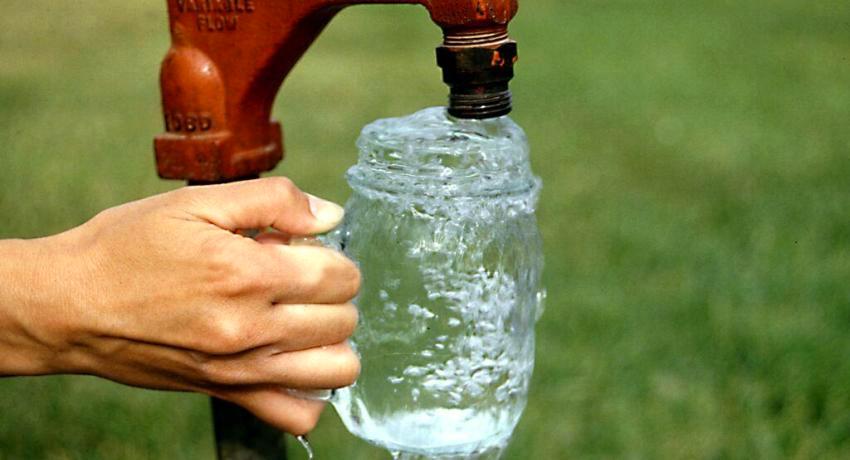
At concentrations of iron in water over 0.3 mg / l, with domestic use, it can cause the formation of rusty streaks and sediment
Well water analysis: consistency and prices
Before using a water well, new or acquired with the site, it is imperative to do a chemical analysis of the water in order to protect yourself, loved ones and households in general. There are a lot of laboratories offering such services. You can decide where to analyze the water from the well if you have the following information about the organization:
- experience in this service sector for at least 5 years;
- the existence of its own laboratory equipment;
- availability of a license for this activity.
Useful advice! Don't be tempted by the low cost of analyzing well water. There is a possibility that the services are offered by intermediaries, which means that obtaining results will be significantly delayed.
The first step in the study is the correct water intake. If a sample is taken from a new well, then this should be done at least two to three weeks after the start of pumping. During this time, all contamination that got into the water during the installation of the well is leveled.
Better to take the dishes from the laboratory. The containers undergo special treatment, preservatives are added to them, which prevent changes in the chemical composition of the water during transportation. The accuracy of the results depends on the cleanliness of the container.
If the dishes are cooked on their own, you must follow certain rules:
- the entire preparation process must be carried out with clean, thoroughly washed and dried hands;
- the container in which it is planned to transport water to the laboratory must be perfectly clean and free of specific odors (the optimal volume of the container is 1.5–2 liters);
- before filling, the dishes should be rinsed several times with water to be analyzed;
- the period of pumping water from the well before sampling should be at least 5 minutes;
- it is advisable to fill the container with a thin stream along the wall of the container. It is not recommended to change the water pressure, the degree of opening of the tap must remain unchanged. The container must be filled with water to the top: the air remaining in the container affects the analysis results;
- the container with the selected water must be signed: indicate the place, date and time of sampling.
To make the analysis of the well water as required, it is important to transport the fluid within 2 hours of being drawn. If fast delivery is not possible, the water must be refrigerated, but not more than 10 hours.
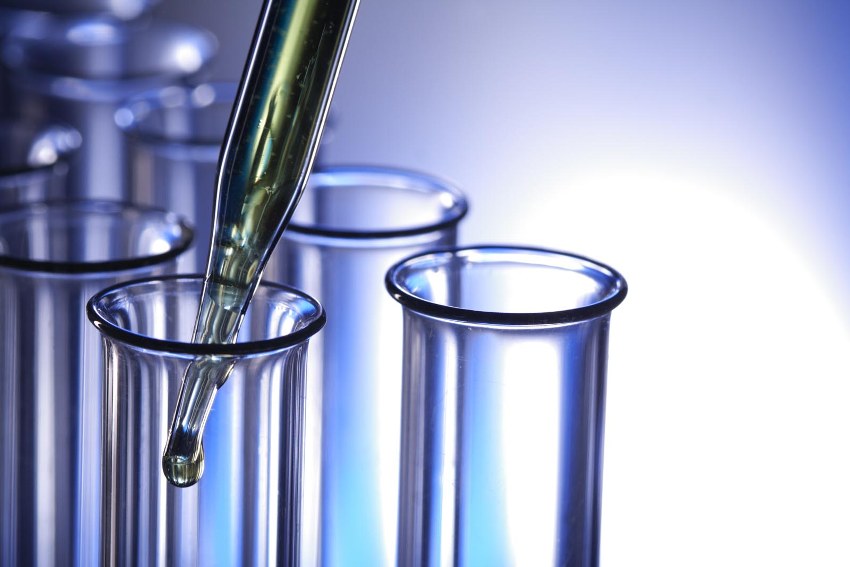
First, a chemical analysis of the water is carried out, which reveals the presence of harmful substances, impurities or dangerous concentrations of elements
To determine the quality of water, there are several types of analysis: chemical, organoleptic, microbiological, advanced.
For different types of water analysis from a well, the price will be different. It mainly depends on how many parameters will be determined, and may slightly increase due to additional services. The average cost of a standard analysis is 1500–2000 rubles, the price of a complete one is 4000–5000 rubles. More accurate information about how much the analysis of water from a well costs, you need to find out directly in the laboratory.
How to clean a well from harmful impurities?
How to purify water from a well, if a chemical analysis showed an amount of iron significantly exceeding the norm?
There are several methods that can be used to remove excess iron from the liquid. By the type of action, such technologies are distinguished:
- reagent;
- reagentless.
The reagent method is water purification using ozone, chlorine, oxidized compounds and other substances. The main principle of their action is to neutralize iron and eliminate harm from it by acting on metal particles. The disadvantage of this method is that the reagents themselves must be changed periodically, since their period of action is short. They are filled into a special cartridge or a suitable filter. Within a short period of time (determined by the level of contamination of the water), the cartridge must also be replaced. Reagents and cartridges are expensive.
Reagentless deferrization of water is a change in composition through the use of aeration method or other systems with a similar effect. Such deferrization is carried out using aeration and filtration units. The following methods are used:
- oxidation;
- biological impact;
- ion exchange;
- aeration.
The oxidation method is based on the action of special substances on the water. A striking example is zones. This substance oxidizes ferrous iron and additionally saturates the liquid with useful substances. The biological effect is carried out by placing certain microorganisms in the water, which transfer the iron particles to a safe state. In the course of applying the biological method, cartridges of rather large sizes are used.
Ion exchange is almost always used for water, which needs not only to be deferred, but also to reduce its hardness. This process is carried out using special resins placed in the cartridge. The reaction takes place at the molecular level. Resins replace and remove foreign matter particles. Aeration is used as a way of oxidizing iron in water. It is based on a natural process, without the use of special substances.
Iron removal from water using production equipment
Water purification in the country is just as important as water purification in a private house, even if it is used for irrigation and technical purposes. An overabundance of individual elements can harm plants, adversely affect various surfaces and materials. Chemical analysis of well water allows you to accurately determine which treatment system should be applied. To date, aeration is considered the most effective among the methods of water purification from impurities. This is a method based on intensive air exchange.
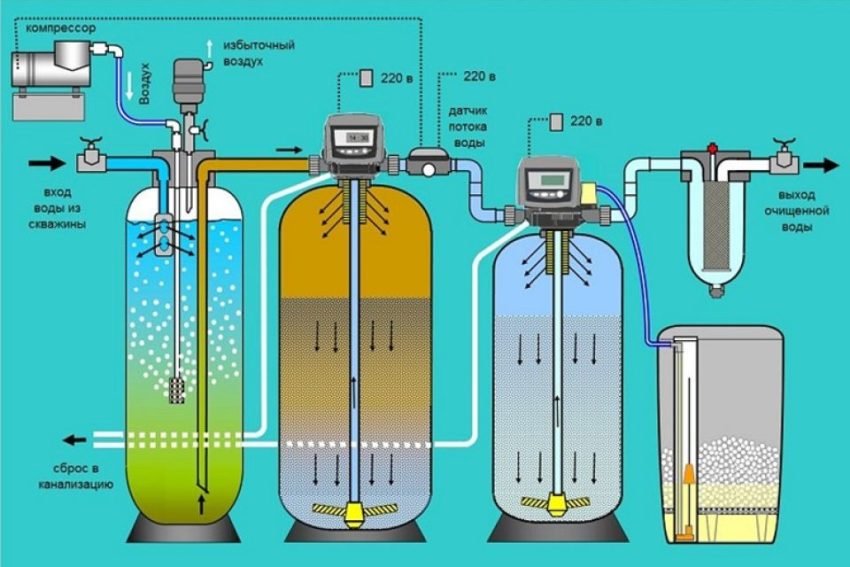
A good purification system consists of several elements to solve common problems of removing iron from water
Based on the technological features of the process, three aeration methods are distinguished:
- pressure head;
- free-flow;
- ejector.
Each of these cleaning methods presupposes the presence of special equipment, has its own technical specifics and stages of implementation.
Pressure aeration
The cost of cleaning a well using the pressure aeration method is significant, since rather complicated technical equipment is used:
- sealed cylinder - column;
- high pressure compressor;
- water flow sensor;
- pressure level sensor;
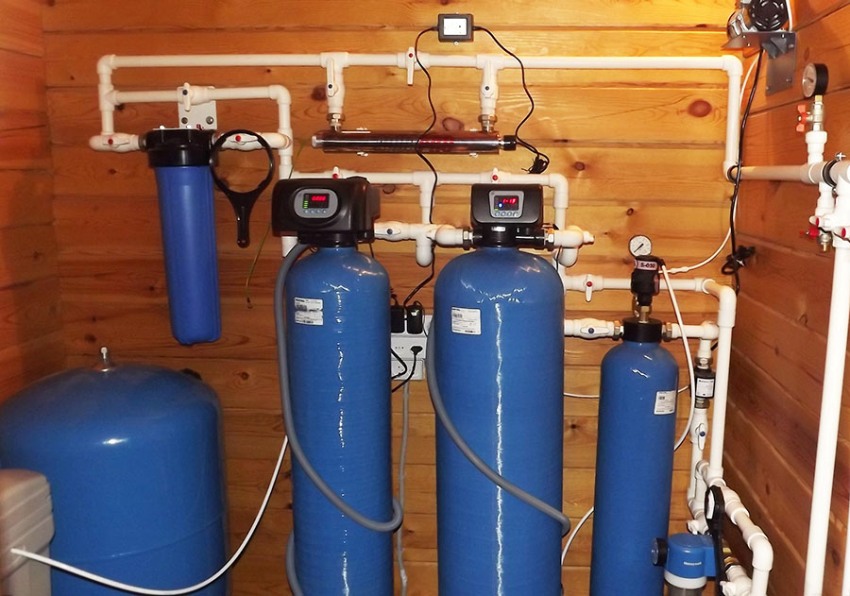
Pressure aeration units are used to saturate feed water with oxygen at significant iron concentrations
- column head with a valve for regulating the pressure inside the cylinder.
From the water supply network, water enters the tank. After the maximum filling, a flow sensor is triggered, which activates the compressor. Then, with the help of a compressor, a stream of air is directed into the chamber under strong pressure. The intense interaction of water with air leads to the oxidation of ferrous iron.
At the end of the aeration process, the water from the column passes through the filter system, which retains oxidized iron particles, and is supplied to the water supply system.The equipment used for pressure aeration is small in size, so it can be used for water purification in a country house.
Gravity aeration
The gravity aeration system consists of the following equipment:
- containers (sealed tank);

The method of non-pressure aeration consists in artificial saturation of water with air, the oxygen of which oxidizes the dissolved iron
- water spray nozzles;
- a compressor and a set of aerators;
- a pump to increase the pressure of the outlet water flow;
- hydroaccumulator;
- block to control the system.
Related article:
Diy water well: effective drilling methods
Diy water well. Drilling tools and equipment. Advice for rational use.
In a sealed aeration tank, nozzles are installed that spray water when it gets into it. Separating into small droplets, water, passing from the upper point, interacts with oxygen as much as possible. The reaction leads to the oxidation of ferrous iron and converts it to ferric.
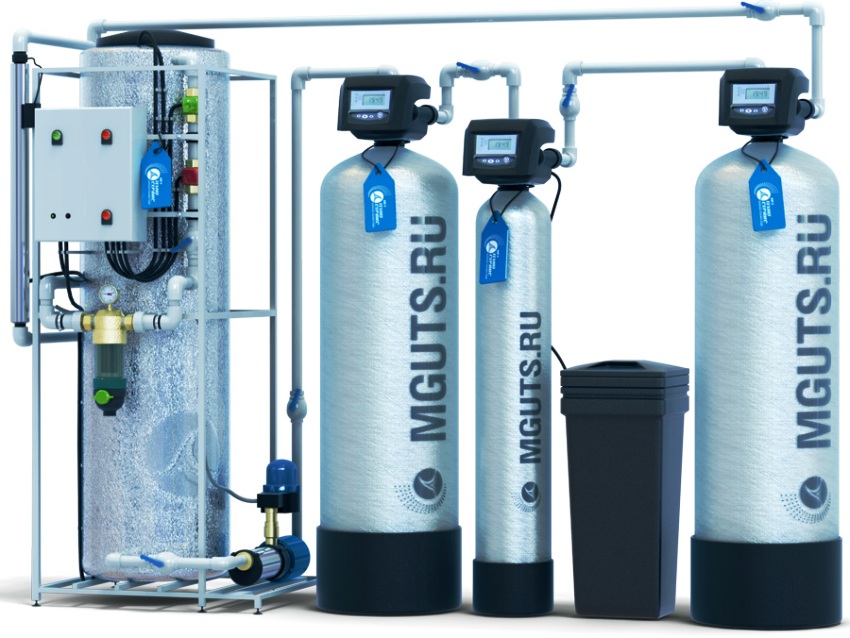
The choice of equipment and the volume of the contact vessel for non-pressure aeration of water depends on many factors.
Due to the spray of water, the outlet flow rate is significantly reduced, therefore, a pump must be connected to maintain the optimum pressure. The need for additional equipment, which entails an increase in material costs and complications in the installation of the system, is a significant disadvantage of this method.
High performance partially compensates for the shortcomings.
Useful advice! If water from the well is planned to be used not only as technical, the tank must be made of food grade plastic.
Ejector method
An inexpensive and widespread cleaning method available for use in everyday life is ejector aeration. The aeration plant is a compact device that uses the energy generated by the flow of water in the pipeline. One of the advantages of the unit is the absence of the need for power supply.
This mechanism is based on the principle of operation of the Venturi device: a zone of reduced pressure is created in the pipe, which contributes to the suction of air bubbles through a special hole. Water outlet through the hole to the outside is impossible, since the device is equipped with a check valve.
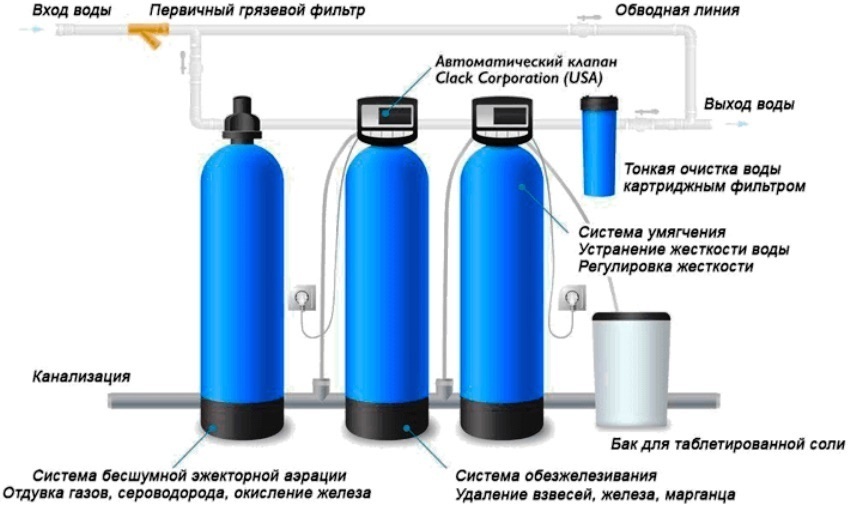
Ejector aeration is the most common method in household use, since it does not require expensive and large-sized equipment
This method does not require the use in the design of cleaning the storage tank or other additional devices. Water, passing through the ejector, is saturated with oxygen and immediately supplied to the filters.
The productivity and intensity of water saturation with oxygen with this method is low, but it is a convenient option for cleaning at the household level.
Useful advice! It is possible to use the ejector method for water purification only if, according to the results of chemical analysis, the level of water pollution does not exceed the average.
Iron filter
Filters for main structures effectively perform the function of purifying water from a well from iron. In most cases, main systems consist of several stages of water purification, each of which uses a cartridge with a filter element. Filter performance will depend on which cartridge is selected. The use of trunk structures has a number of advantages:
- high level of productivity;
- relatively low price;
- ease of installation and operation.
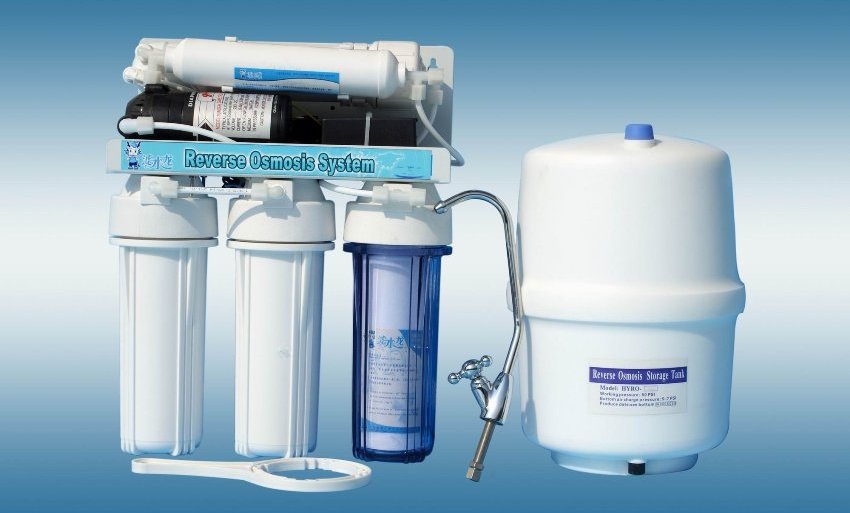
All well filters can be divided into several categories depending on the task at hand
Disadvantages:
- the need for constant replacement of filters;
- use of different models of cartridges for cold and hot water.
Deironing filters can be effectively used only for water with a slight excess of iron.If the indicator exceeds 1–1.5 mg / l, the filter will need to be changed monthly.
Water treatment in the cottage, private house
Poor-quality water means discomfort, additional costs of time and money to fix problems. The need for cleaning it is beyond doubt. Water purification from a well for a private house, a cottage is a rather complex system and requires a careful selection of mechanisms.
There are three main types of cleaning systems for private houses and cottages:
- filters designed to purify water from city water supply;
- filters designed to purify water from a personal well;
- filters designed for water purification in a house with seasonal residence.

Water purification in a private house is a necessity, since water from wells and wells can contain many harmful impurities
In order to correctly select and install a purification system in a private household, it is necessary to analyze the water to determine the chemical composition, and it is mandatory in laboratory conditions. This is the only way to find out what is required to purify water. A full volume of water and good quality is the interaction of filtration and pressure maintenance. It is better to entrust the installation of the system to specialists.
Well water treatment do it yourself
The problem, why the pump does not pump water from the well, can be explained by the following: deposits on the walls, a clogged filter, penetration of impurities into the mechanisms block the supply of water, which contains a lot of iron and is not cleaned of harmful impurities. If the cause is not eliminated, the mechanisms may become unusable. If there is no opportunity to buy equipment for deferrizing water from a well, it is available to develop and assemble it yourself.
The installation scheme for the aeration system is quite simple; it will not be difficult to complete it yourself. This will require:
- plastic tank;
- pipes;
- spray.
In the attic of the house, you need to install a storage tank. Plastic is more suitable, since the material resists corrosion. It is better if this device is not flat, but in the shape of a barrel with a curved bottom. Several pipes must be connected to the tank. The first will directly connect the well and the pump to the installed tank. Through it, water will be supplied to the tank. The pipe should run along the entire length of the container and end with a spray. If there is no spray gun, the end of the pipe can simply be perforated. Thus, a drainage system will be created, which will provide water flowing off in thin streams, which will create a denser contact of the liquid with air and will ensure the activation of the transition of ferrous iron to a trivalent composition.
The second pipe must be connected to the tank on the other side, lifting it to a distance of 20 cm from the bottom level. Iron after oxidation in the form of a precipitate will fall to the bottom, and purified water will be supplied to the system. This water deironing agent has a number of significant advantages:
- efficient at work;
- requires minimal prophylaxis (monitoring the condition of the nebulizer or perforation);
- available for repair;
- low-cost.
The only drawback of this well water purification system is the length of the process. In this way, a tank with a volume of 700-800 liters is cleaned per day.
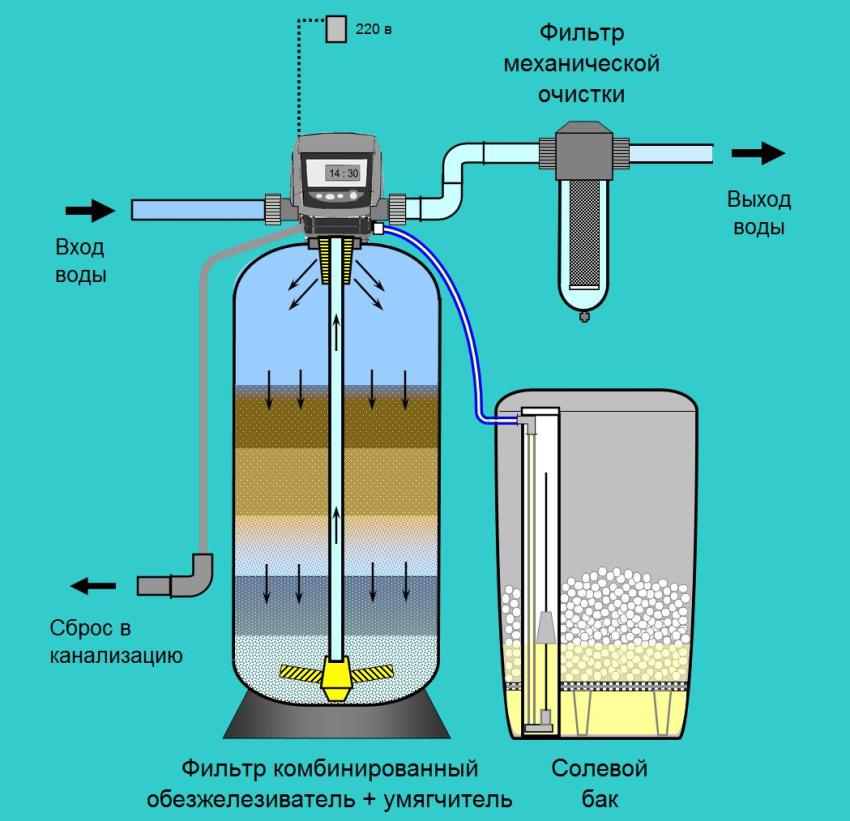
The installation diagram of the aeration system is not complicated, it can be done with your own hands
Well cleaning from silt and sand
With irregular use of the well, a problem of siltation may arise. The water is supplied cloudy, with an unpleasant odor, or does not enter the drainage system at all. Equipment interruptions and poor water quality can also result from sand in aquifers. And in one, and in another case, it is necessary to clean the well from sand and silt. It can be done in two ways:
- chemical;
- mechanical.
During chemical cleaning, reagents are used, which are poured into the well for a certain time (on average, 2 hours). Then the well is flushed for at least 6 hours.
Useful advice! This method is recommended for cleaning wells from silt. If sand is also present, complete cleaning cannot be achieved.
For mechanical cleaning are used:
- water hammer;
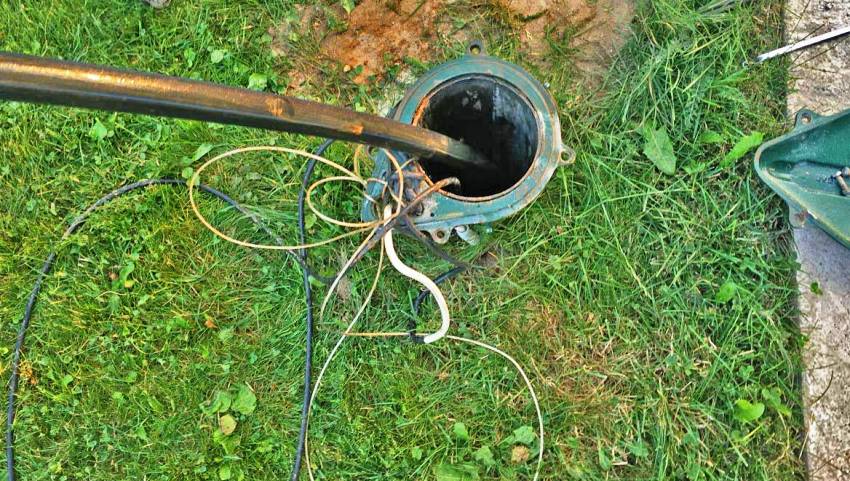
With the help of a thief, the well is cleared of different types of solid particles - silt, sand, dirt and debris
- gelation;
- circulation.
Water hammer is effective in removing sludge and other deposits. Elimination of sand can be carried out using a thief (a pipe into which sand is pumped through a pump - the effect of a vacuum cleaner). The circulation method is the most productive, with its help any deposits are removed.
It is better to entrust mechanical cleaning to professionals. The advantage of cleaning wells from sand and silt with the involvement of specialists is that at the first stage diagnostics will be carried out using modern equipment, the degree and quality of well clogging will be accurately determined. This will allow you to accurately select the cleaning method.
Water purification from a well
The well, due to its openness and the possibility of penetration of pollutants from the outside, needs frequent cleaning. The advantage of this water source is that often the cause of the pollution can be ascertained visually without the need for sophisticated technology. The main signs of well contamination are:
- turbidity and discoloration of the water: black tint - the presence of decomposed substances of organic origin, green - the reproduction of algae due to the penetration of sunlight, yellow - increased iron content;
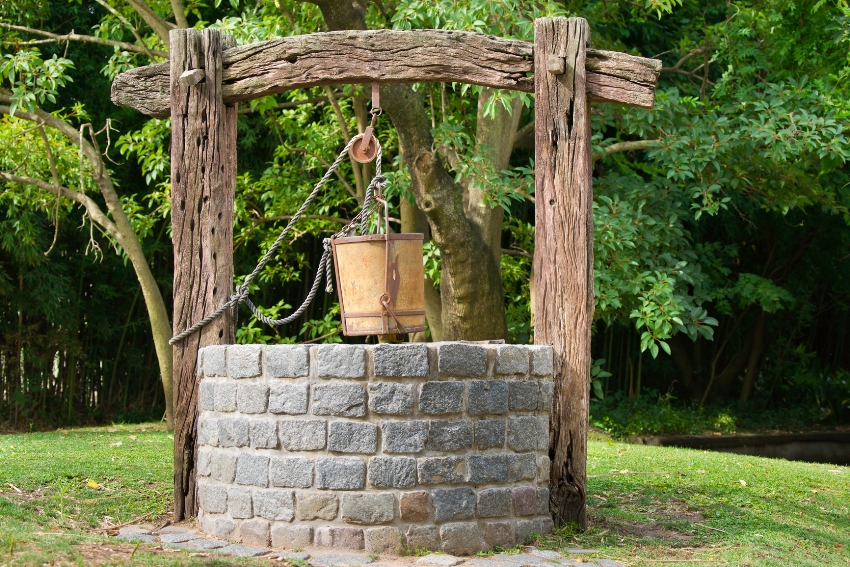
To determine the purification of water from a well, it is necessary to take samples to the laboratory in order to establish what composition of elements is present in it.
- the presence of an unpleasant taste and smell;
- the appearance of clay plaque on the walls;
- lowering the water level.
The entire cleaning process can be divided into several stages:
- testing the condition of the well (external examination, establishing contamination zones);
- finding out the state of well water by laboratory analysis;
- removal of visible impurities, elimination of casing defects;
- repair and cleaning of bottom filters;
- dry cleaning (if necessary).
Since the well environment is most conducive to the development of pathogenic bacteria and the formation of deposits, ultraviolet water treatment is effectively used for wells. It is an alternative to chlorination.
The UV cleaning system is a stainless steel container with UV lamps installed inside. The lamps are housed in special housings that exclude contact with water. Water flowing through the container is exposed to constant ultraviolet irradiation, which allows the destruction of pathogenic microorganisms and formations.
Water purification from iron from a well: mistakes when choosing a cleaning method
Without knowledge of how to purify water from a well from iron, focusing on the external availability of methods, you may not get the expected result. In situations where the choice of the treatment system was made independently, without the participation of specialists and in the absence of the results of a qualified study of the composition of water, a number of typical mistakes are made:
- preference is given to the chemical method as low-cost;
- water hammer is used without understanding the degree of contamination of the well and its condition as a whole. This often leads to damage to the lower part of the structure;
- insufficient circulating flow rate is provided, which leads to incomplete cleaning.
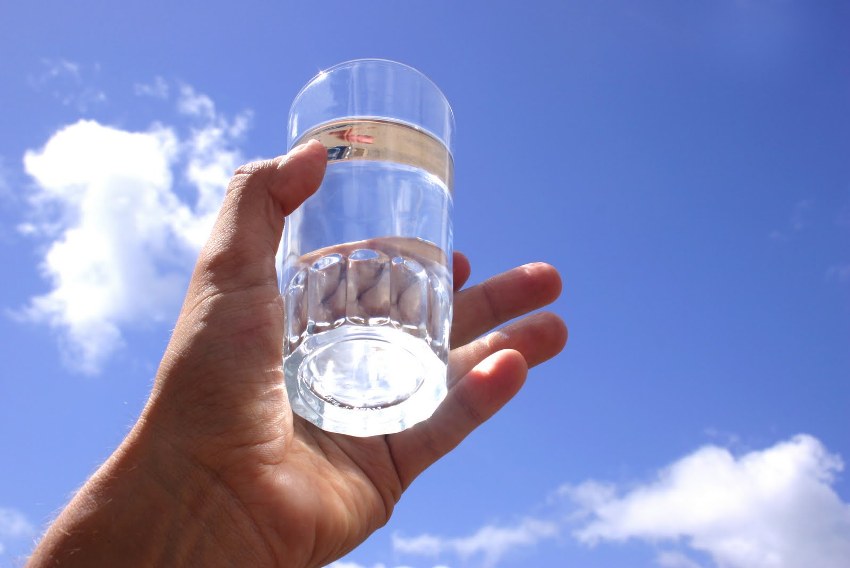
By properly purifying water from a well, it can be made not only safe, but also beneficial to health
Systems for purifying water from a well from iron and other undesirable impurities, installed in compliance with the necessary rules and technical conditions, will not only adjust the chemical composition of water to a state of safety, but also make it useful for health.
